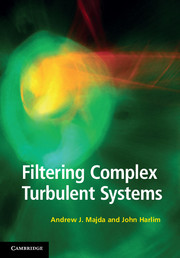Book contents
- Frontmatter
- Contents
- Preface
- 1 Introduction and overview: Mathematical strategies for filtering turbulent systems
- Part I Fundamentals
- Part II Mathematical guidelines for filtering turbulent signals
- 5 Stochastic models for turbulence
- 6 Filtering turbulent signals: Plentiful observations
- 7 Filtering turbulent signals: Regularly spaced sparse observations
- 8 Filtering linear stochastic PDE models with instability and model error
- Part III Filtering turbulent nonlinear dynamical systems
- References
- Index
5 - Stochastic models for turbulence
from Part II - Mathematical guidelines for filtering turbulent signals
Published online by Cambridge University Press: 05 March 2012
- Frontmatter
- Contents
- Preface
- 1 Introduction and overview: Mathematical strategies for filtering turbulent systems
- Part I Fundamentals
- Part II Mathematical guidelines for filtering turbulent signals
- 5 Stochastic models for turbulence
- 6 Filtering turbulent signals: Plentiful observations
- 7 Filtering turbulent signals: Regularly spaced sparse observations
- 8 Filtering linear stochastic PDE models with instability and model error
- Part III Filtering turbulent nonlinear dynamical systems
- References
- Index
Summary
As motivated in Chapter 1, one goal of the present book is to develop an explicit off-line test criterion for stable accurate time filtering of turbulent signals which is akin to the classical frozen linear constant stability test for finite difference schemes for systems of nonlinear partial differential equations as presented in chapter 4 of Richtmeyer and Morton (1967). In applications for complex turbulent spatially extended systems, the actual dynamics is typically turbulent and energetic at the smallest mesh scales but the climatological spectrum of the turbulent modes is known; for example, a mesh truncation of the compressible primitive equations with a fine mesh spacing of 10–50 kilometers still has substantial random and chaotic energy on the smallest 10-kilometer scales due to chaotic motion of clouds, topography and boundary layer turbulence which are not resolved. Similar unresolved features occur in many engineering problems with turbulence. Thus, the first step is the development of an appropriate constant-coefficient stochastic PDE test problem.
The simplest models for representing turbulent fluctuations involve replacing nonlinear interaction by additional linear damping and stochastic white noise forcing in time which incorporates the observed climatological spectrum and decorrelation time for the turbulent field (Majda et al., 2005; Majda and Wang, 2006). Thus, the first step in developing analogous off-line test criteria is to utilize the above approximations. This approach is developed in this chapter and builds on earlier material from Section 2.1.1 and Chapter 4.
- Type
- Chapter
- Information
- Filtering Complex Turbulent Systems , pp. 61 - 71Publisher: Cambridge University PressPrint publication year: 2012



